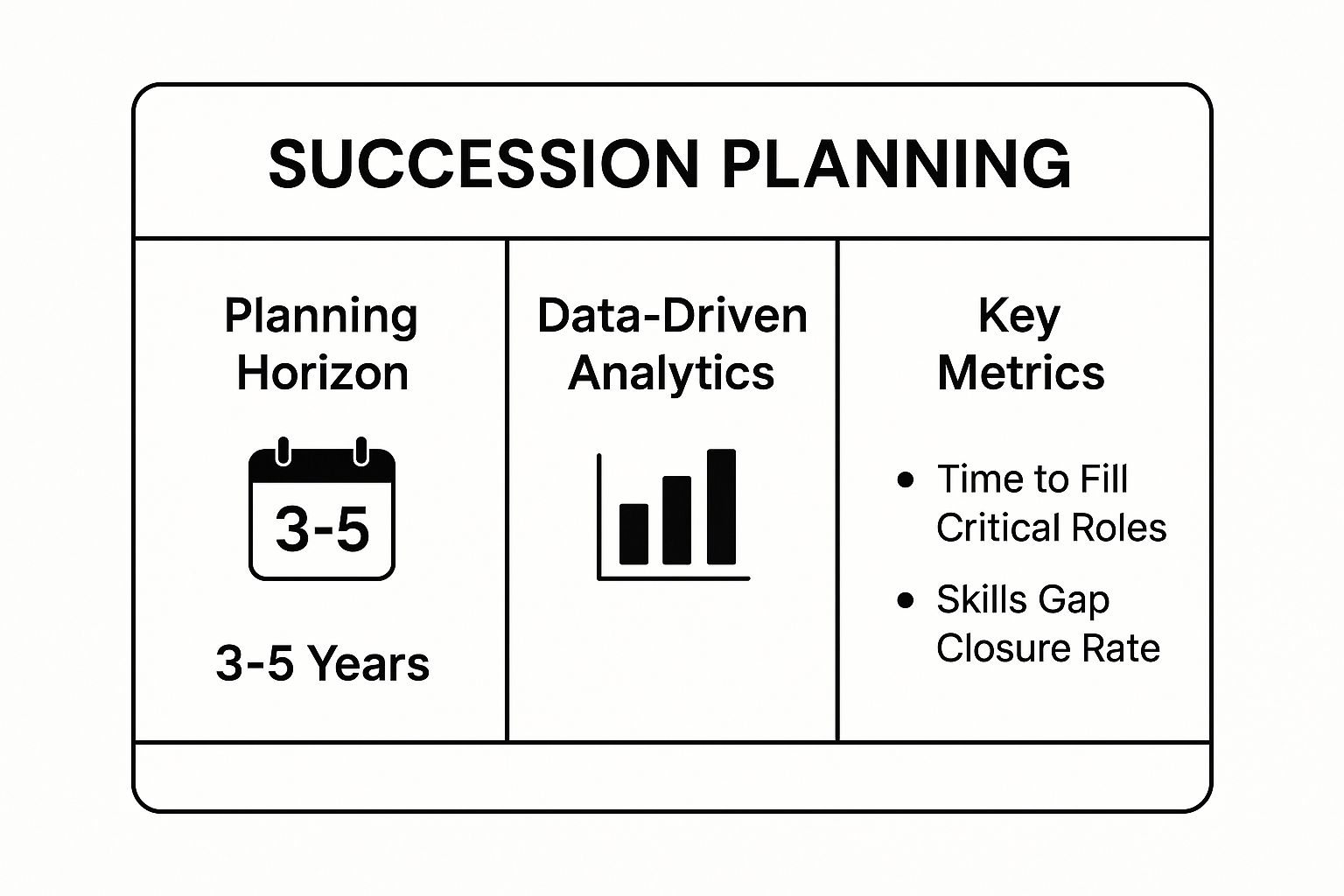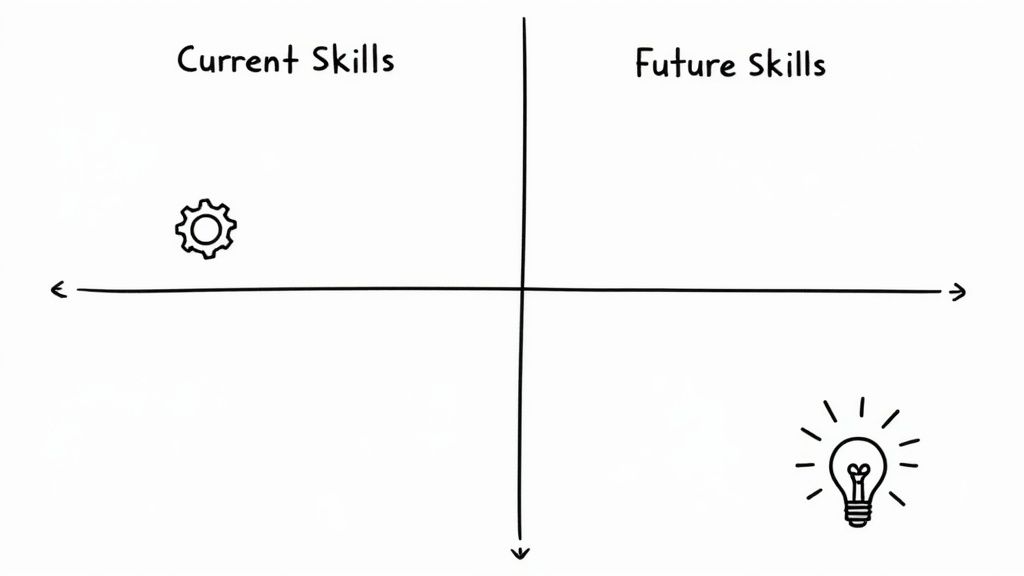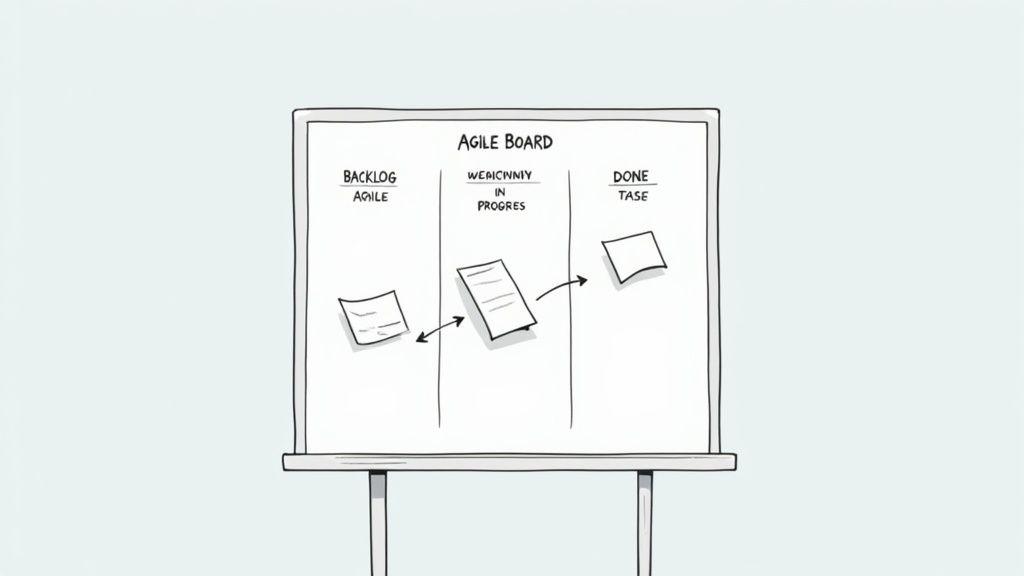
 23 minutes read
23 minutes read
Let’s be honest. Managing a law firm’s headcount feels less like a science and more like a frantic game of whack-a-mole. One partner leaves, and a whole practice area wobbles. A big case lands, and suddenly you’re underwater, begging associates to cancel their vacations. Then the case settles, and you’re overstaffed, staring at a payroll that makes your eyes water. Sound familiar?
This isn’t just bad luck; it’s the predictable result of having no real plan. You're constantly reacting—hiring in a panic, firing in a panic—and burning cash and morale with every swing. It's like running a ship with a crew that's either too small to handle a storm or too large to fit in the lifeboats. The constant churn is expensive, exhausting, and completely avoidable.
Turns out there’s more than one way to staff your firm without mortgaging the office ping-pong table. We've been in the trenches with hundreds of law practices, and we’ve seen what actually works. These aren't vague textbook theories. These are the battle-tested workforce planning strategies that turn chaos into a competitive advantage.
Forget abstract HR-speak; we’re going to walk you through the exact plays that successful firms use to predict their needs, plug skill gaps, and build a team that’s both lean and lethal. Ready to stop patching holes and start building a proper ship?
Forget scrambling to fill a paralegal role a week before a major trial. Strategic Workforce Planning (SWP) is the antidote to reactive, panic-driven hiring. It’s a comprehensive, data-driven methodology that forces you to stop thinking about who you need to hire tomorrow and start planning for the firm you want to be in three to five years. So, you know, actual strategy.
SWP isn't just an HR buzzword; it's a firm-wide strategic initiative. It aligns your talent capabilities with your long-term business goals. Think of it as a blueprint for your human capital. You analyze your current team’s skills, forecast future needs based on growth projections, identify the gaps, and then build a targeted plan to bridge them. This isn't just about hiring; it’s about training, development, and succession planning, too.
So, how do you stop just talking about strategy and actually implement one? First, get your partners and senior leadership in a room. SWP fails without their buy-in because it requires real resources and a long-term commitment. Shocking, I know.
Start with your firm’s five-year business objectives. Are you expanding into a new practice area? Planning to double your client base? Work backward from those goals to define the workforce implications. You’ll need to:
This infographic breaks down the core components of a successful SWP framework.

The key takeaway is that SWP is a long-term, data-centric discipline. It transforms HR from a cost center into a strategic partner in the firm's growth. When it works, anyway.
What happens when your star litigator—the one who brings in half the firm’s revenue—decides to retire and open a vineyard? If your first thought is sheer panic, you don't have a succession plan. Succession planning is the ultimate "don't get caught flat-footed" strategy. It’s a targeted process for grooming internal talent to take over critical roles, ensuring your firm doesn't grind to a halt when key players leave.
This isn't just about finding a replacement for the managing partner. It's about ensuring continuity across all crucial positions. Think of it as building a leadership bench. You systematically identify high-potential individuals, assess their readiness, and create tailored development plans to prepare them. Apple didn't scramble to find a new leader after Steve Jobs; Tim Cook’s transition was years in the making. This is one of the most vital workforce planning strategies for long-term stability.

Ready to stop gambling with your firm’s future? Good. The first step is to get honest about which roles would cause the most chaos if they were suddenly empty. It might not just be your C-suite.
Start by identifying the most critical positions, not just the most senior ones. Is there a senior paralegal who is the only person who understands your complex e-discovery system? That’s a critical role. From there, you can build a robust internal pipeline. You’ll need to:
The goal here isn't to create a secret list of successors but to build a transparent culture of growth. When done right, it ensures business continuity and becomes a powerful tool for retaining your top talent.
Ever look at your team and realize you have a roster of brilliant contract lawyers but nobody who can confidently navigate e-discovery software? That’s a skills gap, and it can grind your firm to a halt. Skills Gap Analysis is the systematic process of figuring out what skills your team has versus what skills it needs to win.
It's about getting brutally honest with your firm's capabilities. This isn't just about identifying weaknesses; it's about pinpointing the exact training, development, or hiring needed to align your team with your strategic objectives. Competency mapping takes this a step further by creating a detailed blueprint for each role, defining the specific skills and knowledge required for success. It transforms hiring from a guessing game into a targeted, data-backed strategy.

Ready to stop hoping you have the right talent and start knowing it? First, accept that this requires a bit of upfront work but pays off massively. Forget generic annual reviews; this is about a deep, operational audit of your team’s skills.
Start by focusing on the roles most critical to your firm’s revenue. What are the high-impact skills that will be non-negotiable in two years? Think AI in legal research, cybersecurity law, or advanced client management. To build your plan:
The key is to treat this as an ongoing diagnostic tool. By regularly analyzing skills gaps, you ensure your firm remains agile and competitive. This is one of the most direct workforce planning strategies for future-proofing your practice.
What happens if that massive tech merger you’re banking on goes south? Or if a new regulation suddenly triples your compliance workload? Relying on a single forecast is like betting your firm’s entire future on one roll of the dice. Scenario Planning is your way of hedging those bets. It’s a disciplined approach to imagining multiple plausible futures, then building a workforce that can thrive in any of them.
This isn’t about predicting the future with a crystal ball; it's about preparing for uncertainty. Pioneered by giants like Shell to navigate oil crises, this strategy forces you to move beyond a single "best guess" forecast. You develop a few distinct scenarios based on key uncertainties—like shifts in client demand or economic downturns—and then model the talent you’d need for each. It’s proactive, which is a nice change of pace.
Ready to stop reacting and start preparing? The goal isn't to create a dozen superficial "what if" situations. It’s about deeply exploring two or three well-developed, contrasting futures to build resilience.
Start by identifying the biggest "what ifs" facing your firm. Is it the rise of AI in legal practice? A major regulatory overhaul? From there, you can build your workforce planning strategies.
The real power here is building an agile workforce. By stress-testing your talent plan against multiple futures, you develop robust and flexible workforce planning strategies that create a resilient firm.
Stop treating every role in your firm as equally critical. Your top-tier M&A partner and your administrative assistant are both valuable, but they don't have the same strategic impact on your bottom line. A one-size-fits-all approach to talent management is lazy and ineffective. Talent segmentation is the practice of strategically dividing your workforce into distinct groups and managing them differently based on their impact.
This isn't about creating an office caste system. It's a pragmatic recognition that different roles require different levels of investment. Inspired by experts like Marc Effron, this strategy forces you to identify your firm’s most critical roles—the ones that directly drive revenue or competitive advantage. This allows you to focus your resources where they’ll generate the highest return, ensuring your "A-players" in "A-roles" get the attention they deserve.
Ready to stop spreading your talent budget like peanut butter? Implementing one of the most effective workforce planning strategies requires a clear-eyed assessment of your firm's structure. Get your leadership team to agree on what truly drives value.
Start by identifying which roles are mission-critical. These are the positions that, if vacant, would significantly disrupt your operations. Is it your intellectual property litigators? Your e-discovery specialists? Once you’ve identified these roles, you can create tailored talent plans. You’ll need to:
The goal is to be deliberate with your talent investments. By focusing resources on the roles and people that propel your firm forward, you build a more resilient and high-performing organization.
The days of crafting a rigid five-year workforce plan and watching it become obsolete in six months are over. Agile Workforce Planning throws that static model out the window, adapting principles from software development to create a talent strategy that can pivot as fast as your firm can. It's about swapping cumbersome annual reviews for continuous, iterative planning cycles that respond to real-time business needs.
This isn’t chaos; it’s controlled, responsive strategy. Instead of a monolithic plan, you operate in short "sprints," focusing on immediate talent priorities while keeping an eye on the long-term vision. This approach acknowledges the reality of today's legal market: a new high-profile case or an unexpected partner departure can completely upend your talent needs overnight.

So, how do you inject this level of flexibility without losing all sense of direction? It starts with a mindset shift from rigid prediction to rapid adaptation. You’ll need cross-functional teams and real-time data to make it work.
Begin by establishing a core workforce planning team that meets frequently. Instead of a year-long project, break down your goals into quarterly or even monthly "sprints." Your focus for one sprint might be beefing up your e-discovery team, while the next could be sourcing flexible talent. Here's a quick-start guide:
Adopting agile principles allows your firm to adjust its talent mix with surgical precision. This is a core component of modern workforce planning strategies, ensuring you can efficiently explore on-demand legal assistant services to meet fluctuating demands without committing to long-term overhead.
Stop making critical talent decisions based on gut feelings and last quarter's hiring panic. Workforce analytics is the answer to getting out of the reactive cycle. This isn't about a fancy dashboard; it's about using hard data to forecast future needs, identify flight risks before they give notice, and pinpoint the exact skills your firm will need to stay competitive. It’s the difference between guessing who your next top performer will be and building a data-backed path to get them there.
This strategy transforms your HR data from a dusty digital filing cabinet into a crystal ball. By applying statistical algorithms to your people data, you can predict outcomes like employee turnover and future skills gaps. While your competitors are throwing money at retention bonuses hoping something sticks, you’re using a model that flags associates at risk of leaving with 90% accuracy, allowing for targeted intervention.
Ready to stop guessing and start knowing? The first step isn't to buy expensive software; it's to ask a better question. Don't start with "Let's analyze our turnover." Instead, ask, "Which of our high-performing associates are most likely to leave in the next six months, and why?" A specific, high-impact question focuses your efforts.
From there, you can build a roadmap for implementing workforce analytics:
This approach turns workforce planning from an art into a science. By leveraging predictive modeling, you're not just filling seats; you're making calculated, strategic investments in your human capital.
Relying solely on full-time hires is like building a ship with no lifeboats. When demand fluctuates, you either have partners drowning in paperwork or you're paying salaries for a team with nothing to do. A flexible workforce strategy is your answer to this all-or-nothing trap. It’s about building an agile, elastic team that can expand or contract with client demands.
This approach means strategically blending your core team with a curated network of part-time staff, specialized contractors, and on-demand freelancers. Think of it as creating a "talent bench" you can call upon for specific projects or seasonal spikes in litigation. It’s one of the most effective workforce planning strategies because it gives you immediate access to skills without the long-term overhead of a full-time hire. You get the expertise precisely when you need it, and only for as long as you need it.
Ready to stop paying for downtime? The first step is to get honest about which roles are truly core to your firm’s daily operations versus those that support peak demand. This isn't about replacing everyone; it's about being smarter with your resources.
Your goal is to build a hybrid model that provides stability and flexibility. To do this, you'll need to:
By embracing this model, you can scale your firm without adding crippling overhead. The key is to treat your contingent workforce as a strategic asset, not just a temporary fix.
Let's be honest: in many firms, workforce planning is an HR project that business leaders politely ignore until they desperately need to hire someone. Integrated Business and Workforce Planning (IBWP) demolishes that silo. This isn't just about HR talking to the business; it's about embedding talent strategy into every core business decision.
IBWP treats your people as a core component of your firm's capacity, right alongside your financial capital. Instead of planning your budget and then figuring out who you can afford, this approach forces you to consider talent implications from day one. It aligns your firm’s strategic goals, financial plans, and talent pipeline into a single, cohesive roadmap. It prevents you from writing checks your talent pipeline can't cash.
How do you make this happen without it becoming another series of unproductive meetings? You start by breaking down the walls between finance, operations, and HR. This is less about new software and more about a new mindset.
Your goal is to make workforce considerations a non-negotiable part of your firm’s regular business reviews. When your partners discuss opening a new office, the first questions shouldn't just be about real estate costs. They should be: Do we have the partner-level talent to lead it? What are the local talent pools for paralegals and associates?
To get started, try to:
The key is to stop treating people as an expense to be managed and start treating them as the core asset driving your firm's revenue. This makes your workforce planning strategies not just an HR function but a central pillar of your firm’s success.
| Item | Implementation Complexity | Resource Requirements | Expected Outcomes | Ideal Use Cases | Key Advantages |
|---|---|---|---|---|---|
| Strategic Workforce Planning (SWP) | High – complex and data-intensive | Significant time, analytics tools, leadership engagement | Proactive talent gap identification, long-term readiness | Organizations aligning workforce to long-term strategy (3-5 years) | Aligns workforce with business strategy, improves agility, reduces recruitment costs |
| Succession Planning | Moderate – focused on leadership roles | Investment in development programs, assessment resources | Business continuity, leadership pipelines maintained | Preparing internal candidates for key leadership roles | Ensures smooth leadership transitions, retains high potentials, reduces external hiring |
| Skills Gap Analysis and Competency Mapping | Moderate to High – detailed assessments and frameworks | Assessment tools, continuous updates, LMS integration | Targeted training, informed recruitment, improved workforce agility | Identifying skill gaps for learning and hiring decisions | Clear guidance for development, supports internal mobility, data-driven decisions |
| Scenario Planning and Workforce Modeling | High – sophisticated analytics and scenario development | Advanced analytics capabilities, leadership time | Flexible strategies for multiple future states | Managing uncertainty and market volatility in workforce planning | Builds resilience, prepares for multiple scenarios, informs strategic conversations |
| Talent Segmentation Strategy | Moderate – requires clear criteria and communication | Data analysis, stakeholder management, regular reviews | Optimized resource allocation, tailored talent strategies | Differentiating workforce investments by role criticality | Enhances ROI on talent, clarifies critical roles, supports targeted development |
| Agile Workforce Planning | Moderate – cultural shift and frequent cycles | Real-time data systems, cross-functional teams | Rapid adaptation to changing business conditions | Fast-changing, uncertain environments requiring flexible plans | Increases agility, promotes collaboration, reduces lengthy planning delays |
| Workforce Analytics and Predictive Modeling | High – technology and expertise intensive | Advanced analytics tools, data quality management | Data-driven insights, accurate forecasts, early risk detection | Organizations seeking evidence-based workforce decisions | Reduces bias, predicts challenges, quantifies ROI, supports strategic planning |
| Flexible and Contingent Workforce Strategy | Moderate to High – managing diverse workforce types | Vendor management, compliance, integration systems | Workforce scalability, cost flexibility, access to specialized skills | Businesses needing workforce elasticity and cost control | Scales workforce easily, reduces fixed costs, accesses on-demand skills |
| Integrated Business and Workforce Planning | High – cross-functional integration and process redesign | Collaboration tools, analytics, business and HR capabilities | Holistic organizational capacity view, aligned planning | Embedding workforce planning into overall business strategy | Aligns talent directly with business goals, improves forecast accuracy, shared accountability |
Alright, let's be honest. You've just read a comprehensive list of sophisticated-sounding workforce planning strategies. You're nodding along, maybe you even bookmarked this article. But here’s the cold, hard truth: the gap between knowing this stuff and doing it is a chasm where most law firms' ambitions go to die.
You can create the most beautiful succession plan the ABA has ever seen and run scenario models that would make a Wall Street quant blush. But none of it matters if your execution layer is stuck in the past. The fundamental problem hasn't changed: traditional legal hiring is a slow, expensive, and rigid beast.
Think about it. You identify a need for a full-time associate. Great. Hope you enjoy spending your afternoons fact-checking resumes and running interviews—because that’s now your full-time job. Three months and a hefty recruiter’s fee later, you hire someone, only to realize the case settled. That’s not a strategy; it's an expensive gamble. This is precisely why a flexible, on-demand talent strategy isn't just one of the options. It’s the linchpin that makes all the others actually work.
Every single strategy we've discussed becomes exponentially more powerful when you have a flexible talent layer.
This is the new leverage. It's about moving from a reactive stance, where you're constantly scrambling to fill seats, to an orchestral one, where you conduct a blended team of core employees and on-demand specialists. Need to staff up for a massive discovery project? Tap into a network of vetted, remote paralegals in less than 24 hours. Need specialized expertise for a single case? Bring in a fractional junior attorney without adding a single dollar to your permanent payroll.
This agile approach is the ultimate ‘no-regrets’ move. It allows you to test, learn, and adapt without being locked into costly, long-term decisions.
Look, we've been in the trenches. We’ve felt the pain of turning down work because we couldn't staff up fast enough. We've watched our best people burn out. That’s why we built the platform we wish we’d had running our own firms. It’s a curated network of over 10,000 legal professionals, ready to plug into your operations when you need them and unplug when you don’t. (Toot, toot!) This isn't just about filling a temporary gap; it’s a fundamental shift in how you build your firm's most valuable asset: its people.
So, here’s my challenge to you. Don’t let this article become just another open tab in your browser. Pick one strategy from this list. Just one. Start there. And when you realize that a flexible talent layer is the secret sauce to making it stick, you know who to call.
Ready to stop admiring the problem and start building a more agile, resilient, and profitable firm? Explore our network of over 10,000 vetted, on-demand legal professionals at HireParalegals and see how you can implement modern workforce planning strategies today. Visit HireParalegals to post a job and get matched with elite talent in hours, not months.